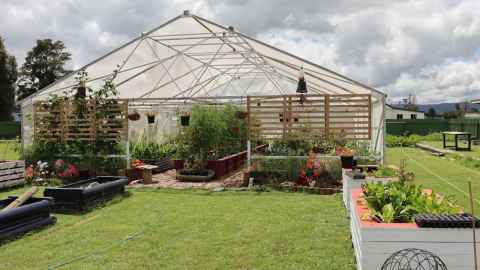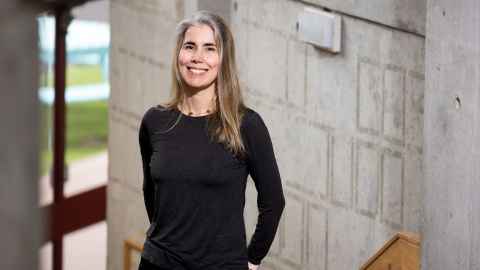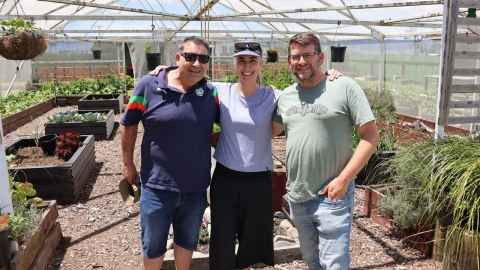Food for thought: public space blooms into edible landscape
12 December 2023
A project to transform an abandoned bowling green into a food oasis highlights how public spaces could be used to provide free food for all.

University of Auckland researchers are reimagining how public spaces can be used to feed our cities and tackle significant challenges, such as widespread biodiversity loss and increasing health concerns linked to food choices.
Dr Barbara Ribeiro from the Faculty of Creative Arts and Industries and her research team implemented a public edible landscape in Waharoa, a rural community in the Waikato region.
The 400 square metre space started as an abandoned bowling green and has blossomed into an edible garden that offers residents freshly harvested fruit and vegetables for no cost.
The project is grounded in repurposing public land and seeks to turn food into a public service. Instead of the traditional community garden approach, where gardeners own the produce, this project encourages public participation in planting and harvesting, and sees food as a shared resource for people and pollinators.
“Community gardeners tend to see the fruits of their labour as their own, and rightfully so, because it's a lot of work. The difference is that these edible landscapes welcome everyone to harvest food, even if the produce was grown by someone else.”

Ribeiro was pregnant with her son Nicolas when her concerns about the health and environmental impacts of the food system led her to envision a future where public spaces are adorned with vegetable gardens and fruit trees, enabling anyone to harvest food for a meal.
She says that much more could be done to enable the use of public spaces to offer free food for all, while providing safe habitats for pollinators, such as bees and birds, to thrive.
“Our view is that we’re not even close to what we could be getting out of our public spaces.”
The edible landscape in Waharoa was built in partnership with the Matamata-Piako District Council and Māori community group, the Kaitiaki Trap’n Train Trust in January 2023. The garden features a variety of crops and non-edible plants, as well as culturally appropriate foods, such as kamo kamo.
Ribeiro says that pollinator surveys confirmed 14 visiting species were drawn to the edible landscape in Waharoa. Preliminary analysis of interviews with community leaders and members also show that people in the region are learning about new foods and ecosystem services, connecting with indigenous knowledge and seeing positive effects on health.
“Diabetes and obesity are skyrocketing in the region, and the garden is seen by community members as an opportunity to teach people about new vegetables that they could benefit from. There is also an aspect of social reconnection that revolves around food, and we’re seeing that being normalised in Waharoa.”

Ribeiro’s research has also focused on the Epicurious Garden in Brisbane, an urban edible public garden with government backing, similar to the Waharoa initiative, where visitors can freely acquire freshly harvested fruit and vegetables.
The Brisbane model, though different from the grassroots approach in New Zealand, underscores the multifaceted benefits of such initiatives.
“Themes emerging from discussions with participants showed that parents were thrilled to have a space in which they can show their kids where their food is coming from and how it grows. Additionally, people expressed joy in having a place to socialise, while others found that it really makes a difference at the end of the month when it comes to how much they pay for food. There are all those different kinds of dynamics happening.”
The Waharoa and Brisbane sites show there is a pathway for change that could be upscaled nationally and internationally, says Ribeiro.
“There is a long-term vision that I have for this project. I hope that our evidence-based insights about how regenerative placemaking enables social food reconnection and pollinator biodiversity can help more people look into public spaces, and ask, ‘why not?’
“Parts of parks, parking lots and even small squares could offer so much more. It's cheap, it's easy and people get so much value out of it. Our findings demonstrate that beautiful, public edible landscapes can have such a positive impact on wellbeing and biodiversity.”
Media contact
Hussein Moses | Media adviser
M: 027 361 1000
E: hussein.moses@auckland.ac.nz